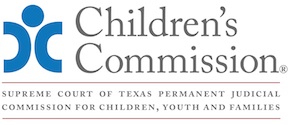
Texas Child Protection Law Bench Book
Updated September 2025
A. Medical Consenter
Tex. Fam. Code § 266.004(h) requires medical consenter training, which must include training related to informed consent for the administration of psychotropic medication and the appropriate use of psychosocial therapies, behavior strategies, and other non-pharmacological interventions that should be considered before or concurrently with the administration of psychotropic medications. Tex. Fam. Code § 266.004(h-1).
Each person required to complete a training program under Tex. Fam. Code § 266.004(h) must acknowledge in writing that the person:
• Has received the training described by Tex. Fam. Code § 266.004(h-1);
• Understands the principles of informed consent for the administration of psychotropic medication; and
• Understands that non-pharmacological interventions should be considered and discussed with the prescribing physician, physician assistant, or advanced practice nurse before consent to the use of a psychotropic medication. Tex. Fam. Code § 266.004(h-2).
The DFPS Medical Consent Training for Caregivers is available online and typically takes an estimated two and half hours to complete.[143]
DFPS also has a two-hour online Psychotropic Medication Training for DFPS staff, foster parents and residential providers, relative caregivers, and youth medical consenters.[144]
1. Informed Consent
Although the term “informed consent” as it relates to medical care for a child in foster care is not defined in Tex. Fam. Code Chapter 266, the Texas Legislature has defined consent for psychotropic medication. Consent to the administration of a psychotropic medication is valid only if:
• The consent is given voluntarily and without undue influence;
• The person authorized by law to consent for the foster child receives verbally or in writing information that provides:
◦ the specific condition to be treated;
◦ the beneficial effects on that condition expected from the medication;
◦ the probable health and mental health consequences of not consenting to the medication;
◦ the probable clinically significant side effects and risks associated with the medication; and
◦ the generally accepted alternative medications and non-pharmacological interventions to the medication, if any, and the reasons for the proposed course of treatment. Tex. Fam. Code § 266.0042.
The Parameters describe what is meant by “informed consent” by stating that consent to medical treatment in non-emergency situations must be obtained from appropriate parties with the child or adolescent assenting before beginning psychotropic medication, which includes discussing the following with the prescribing provider before consenting:
• A DSM-5 (or current edition of the American Psychiatric Association's [APA] Diagnostic and Statistical Manual of Mental Disorders) psychiatric diagnosis for which the medication is being prescribed;
• Target symptoms;
• Expected benefits of treatment;
• Risks of treatment, including common side effects, laboratory finding, and uncommon but potentially severe adverse events;
• Risks of no treatment; and
• Alternative treatments available and/or attempted treatments.[145]
Included in the idea of informed consent is the consideration of alternative treatments and trauma-informed care. The concept of trauma-informed care is a paradigm shift for the entire system and acts as a lens through which children, youth, and families experiencing the child welfare system are viewed. The Introduction and General Principles Section of the Parameters promote a trauma-informed child and family-serving system where all parties involved recognize and respond to the varying impact of traumatic stress on those who have contact with the system, including youth, caregivers, and service providers. A robust trauma-informed system should not only screen for trauma exposure and related symptoms, but also use culturally and linguistically appropriate, evidence-based assessments and treatment.
In 2015, the 84th Texas Legislature added Tex. Fam. Code § 266.012 regarding comprehensive assessments. Described in detail in the Health Care chapter herein, the comprehensive assessment for children and youth in state conservatorship is called CANS and is administered in a developmentally appropriate way not later than the 45th day after the date a child enters the conservatorship of DFPS. This statute was updated in 2017 to require that any Single Source Continuum Contractor (SSCC) providing therapeutic foster care services to a child ensure that the child receives a comprehensive assessment at least once every 90 days. Tex. Fam. Code § 266.012(c). The assessment must include:
• A screening for trauma; and
• Interviews with individuals who have knowledge of the child's needs. Tex. Fam. Code § 266.012(a).
DFPS requires that children and youth placed in substitute care ages 3 to 17 years old receive a CANS assessment within 30 days of removal. The CANS is used to gather information about the strengths and needs of the child and family and is used in Service Planning to assist the child and family in reaching their goals.[146] DFPS may consent to healthcare services ordered or prescribed by a healthcare provider authorized to order or prescribe healthcare services regardless of whether services are provided under the medical assistance program under Tex. Hum. Res. Code Chapter 32, if DFPS otherwise has the authority under Tex. Fam. Code § 266.004 to consent to healthcare services. Tex. Fam. Code § 266.004(k).
2. Monitoring Use of Psychotropic Drugs
The medical consenter shall ensure that the child has been evaluated by the prescribing physician, physician assistant, or advanced practice nurse at least once every 90 days to allow the physician, physician assistant, or advanced practice nurse to:
• Appropriately monitor the side effects of the medication; and
• Determine whether:
◦ the medication is helping the child achieve the treatment goals; and
◦ continued use of the medication is appropriate. Tex. Fam. Code § 266.011.